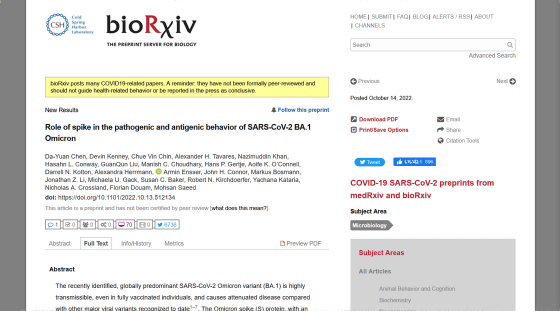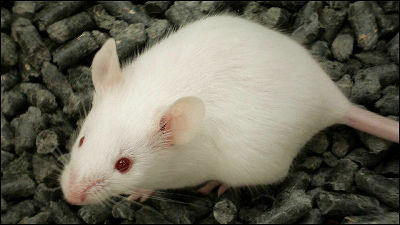Boston University created a ``hybrid new coronavirus'' that combines two virus strains, and the university countered the voice accusing it of being dangerous

A research team at the
Role of spike in the pathogenic and antigenic behavior of SARS-CoV-2 BA.1 Omicron |
https://www.biorxiv.org/content/10.1101/2022.10.13.512134v1.full

NEIDL Researchers Refute UK Article about COVID Strain | The Brink | Boston University
https://www.bu.edu/articles/2022/neidl-researchers-refute-uk-article-about-covid-strain/
Researchers' tests of lab-made version of Covid virus draw scrutiny
https://www.statnews.com/2022/10/17/boston-university-researchers-testing-of-lab-made-version-of-covid-virus-draws-government-scrutiny/
The hybrid consists of the omicron variant's spike protein attached to the original virus | Live Science
https://www.livescience.com/hybrid-covid19-virus-sparks-controversy
On October 14, 2022, the NEIDL research team discovered that the Wuhan strain, which was prevalent in the early stages of the pandemic of the new coronavirus infection (COVID-19), was fused with the spike protein of the Omicron strain, which is the mainstream strain at the time of writing the article. A paper about creating a recombinant novel coronavirus (hybrid strain) has been published on bioRxiv, a database of pre-peer-reviewed papers.
When the research team investigated the lethality of the Wuhan strain, the Omicron strain, and the hybrid strain using experimental mice, 100% of the experimental mice died in the Wuhan strain, no mice died in the Omicron strain, and the hybrid strain 80% died. From the results of this study, the research team concluded that ``the low severity of the Omicron strain is not caused by mutations in the spike protein, but by another protein.'' ``Identifying these proteins will enable better diagnostics and disease control strategies,'' said Associate Professor Mohsan Saeed of NEIDL, the corresponding author of the paper.

Regarding this paper, the British Daily Mail reported that ``We developed a ``hybrid new coronavirus'' that kills 80% of mice,'' and also introduced comments from researchers who criticized this research as being dangerous and should be banned. Did.
Outrage as Boston University CREATES Covid strain that has an 80% kill rate | Daily Mail Online

Israeli scientist Shmuel Shapira commented, ``This is like playing with fire and should be banned completely. A clear example: enhanced scrutiny of potential pandemic pathogen research is needed if we are to avoid the next 'laboratory-made pandemic',' he told the Daily Mail. rice field. Several media outlets followed the Daily Mail and reported in a tone condemning the development of a hybrid novel coronavirus.
In response to these reports, Boston University said, ``We would like to address the false and inaccurate reporting in the Daily Mail about Boston University's COVID-19 study. It's not a study, which means it didn't make the Wuhan strain of novel coronavirus discovered in Washington state stronger or more dangerous, and in fact the study did make the virus' replication less dangerous. I have issued a statement to the contrary.
'The media sensationalized the message and misrepresented the entire research and its goals,' NEIDL director Ronald Corley said. I was interested in,' he said. The mice used in the study were of a highly susceptible type, and even the Wuhan strain, which has a mortality rate of less than 1% in humans, had a mortality rate of 100%, so only the ``80% mortality'' part. I pointed out that extracting distorts the context. In addition, the study was approved after multiple safety reviews and was safe at a biosafety level 3 facility.

However, reports in the Daily Mail and STAT allege that NEIDL did not disclose its research to the National Institute of Allergy and Infectious Diseases (NIAID) , one of the institutions that funded the project.
Emily Erbelding, director of NIAID's Division of Microbiology and Infectious Diseases, told STAT that Boston University's grant application did not specify exactly what the study was about. I think we will have a dialogue with Boston University.' He also said the NIAID would have convened a risk assessment committee had it known the research team was developing a chimeric virus, saying, 'What we wanted to do was ask what the research team was doing. It is to discuss in advance whether you want to do it, ”he insisted. In addition, Mr. Erbelding said that the lethality rate of experimental mice is different from humans, and the headline '80% lethality rate' is not appropriate.
On the other hand, Boston University claims that NIAID's funding was used to support the development of the tools and platforms used in the research, but that the experiment itself was funded by Boston University. He further emphasized that the current study was not a gain-of-function study, stating, 'We met all required regulatory obligations and protocols. In accordance with NIAID guidelines and protocols, we We were under no obligation to disclose this study for any reason.'
Scientific media Live Science says this discrepancy may be due to ambiguity in the NIAID framework. The research team did not believe that the mice used in the experiment were sufficiently similar to humans and may not have reasonably expected that the virus could cause a pandemic in humans. did.
Related Posts:
in Science, Posted by log1h_ik







